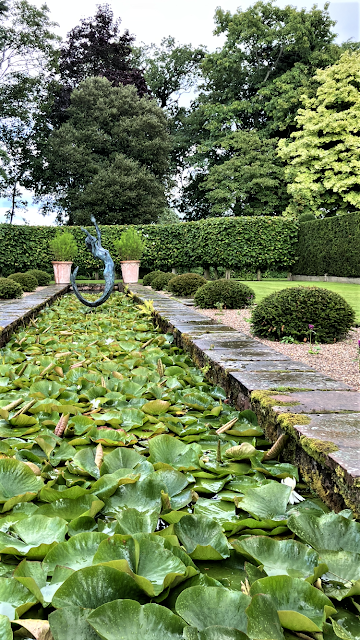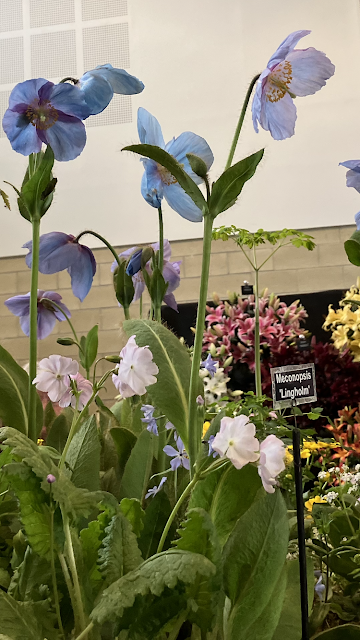We were so lucky to have Cumbria’s renowned dahlia breeder, Mr
Jack Gott from Milnthorpe talking to us
this month. Jack has been a passionate
grower of dahlias for 52 years and grows over 300 varieties and
stocks upwards of 6,000 dahlias each year. The recent winter frosts
however, have diminished many of his tubers so he envisions lots of
work this year replenishing his stock!
Jack
is fortunate to live adjacent to his one and a half allotments, so he
is on hand to care for and tend this enormous collection. Jack
successfully exhibits his dahlias all around the country, and also
sells dahlias to the public.
Some
time ago, Jack stopped digging his dahlia beds each year, and has
lessened his weeding by paving between the rows of flowers. Specially
made fishing nets are used as plant supports. Chicken
manure pellets and compost are used to enrich his soil.
By
using many photographs to illustrate his talk, it was clear to see
the scale of work involved and Jack’s
level of passion for dahlias. He
maintains
and propagates
his stock, attends
National Shows / Plant
Fairs and develops
and breeds
many new varieties.
To
propagate dahlias, Jack described how he takes cuttings from every
tuber…..at least two dozen from each. The four-inch cuttings are
popped closely together in trays of dry sand. When the tray is full
he waters it and leaves the cuttings to root. No feeding or
mollycoddling, only watering again once the sand is dry. He
recommended spraying the cuttings with water if they look droopy and
to avoid them getting waterlogged. Jack advocated ’treat
‘em rough’! Once each cutting
has developed roots, it is potted into compost. These new plants are
grown on to be sold as tubers the following year.
There
were many interesting slides both of Jack’s own production
nursery/allotments and his show
exhibits together with pictures from the Netherland producers who are
world renowned dahlia growers. Many photographs too, of the amazing
range of colours and different forms of dahlia which are available,
cacti, pom-pom, anemone, singles, and waterlily to name but a few.
“The
Dahlia is one of the most beautiful of the native American flowers.
They were used abundantly by the Aztecs
of Mexico, as food,
medicine and of course, decorations!
Very
little is known about the early history of the Dahlia due to the
destruction of the Aztec culture after the Spanish Conquest.
Francisco Hernadez was sent to Mexico by King Phillip II of Spain in
1570 to study it’s natural resources. He stayed for 7 years and was
the first to describe the plants we know as Dahlias today. He called
them Acocotli and Cocoxochitl.
In
October of 1789, the first Dahlia bloomed in Europe at the Madrid
Botanical Garden. By the early part of the 1800s, Dahlias were
growing in luxurious gardens all over Europe.
The
thing about Dahlias that sets them apart from other flowers in the
plant world is the fact that they are octoploids.
This means they have eight sets of chromosomes, whereas most plants
only have two. (Humans have 23.) This gives the Dahlia the unique
ability to be cultivated with an
extremely
high variety of results.
CLASSIFICATION
OF DAHLIAS
Dahlia
varieties are based not only on shape, but size. Dahlias are a genus
with 30 species and over 20,000 cultivars… (Big family!)
Dahlia
Size Categories:
Giant
(AA) – over 10″ diameter
Large
(A) – 8-10″ diameter
Medium
(B) – 6-8″ diameter
Small
(BB) – 4-6″ diameter
Miniature
(Min) – 2-4″ diameter
Mignon
– to 2″ diameter

1.
Formal Decorative Dahlias (FD) – flat, rounded florets regularly
arranged.
2.
Informal Decorative Dahlias (ID) – twisty, curvy or wavy florets
arranged irregularly.
3.
Semi-cactus Dahlias (SC) – ray florets that can be straight,
incurved or recurved
4.
Straight-cactus Dahlias (C)- ray florets arranged regularly
5.
Laciniated Dahlias (LC) – twisted and split, ray florets
6.
Waterlily Dahlia (WL) – broad, slightly cupped florets
7.
Collarette Dahlia – single row of ray florets around a center ring
of shorter florets
8.
Anemone Dahlia – ray florets composed around central tubular disk
florets
9.
Ball (Ba), Miniature Ball (MBa) Pompon (P) – ball-shaped or
slightly flatted flowerheads
10.
Single Dahlia – One row of uniform, ray florets
11.
Orchid Dahlias – single row of ray florets with inward-curving
margins
Novelty
Dahlias (NO) – Dahlias whose characteristics do not fit into any
other category.
https://www.flowershopnetwork.com/blog/dahlia-flower-day/
Jack
described how to recognise ‘sports’,
an anomaly on the plant which often creates a new variant to breed
from. Some may become named varieties, but others are discarded as
not commercially viable. Breeders over the years have developed a
huge variation within the species.
More
information can be found on the National Dahlia Society’s website
https://www.dahlia-nds.co.uk
Dalemain
Plant Fair is a great local
venue where a large collection of dahlias (as well as other plants)
can be seen and purchased. This year it will be held on 11th June at
Dalemain. To conclude his interesting talk, Jack played a video of
when he was featured on a Gardener’s World programme in 2016.
.jpg) |
| https://vimeo.com/159788504
|
There
were many dahlia tubers available for members to buy afterwards.
Written
by Jude Jansen
Compiled
for blog by Trish Rodgers
Photos
– various / Internet































.jpg)





.jpg)

.jpg)
.jpg)
